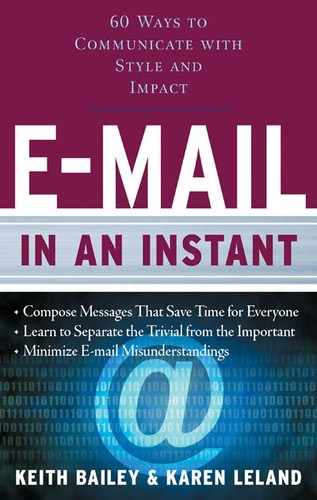38
Sort Through Spam
Just in case you have been in a cave (without a wi-fi connection) for the past decade, spam is the unwanted, unsolicited e-mail everyone receives in their inbox—day in and day out. Spammers (those who spam) send bulk mailings indiscriminately to millions of e-mail users, the result being that inappropriate and unwanted messages (Jim Johnson would you like a bigger …) show up in your mailbox at work or at home. Only after sorting through seedy listings for pornography, gambling, organ enlargement, and an array of pharmaceuticals can you get to your legitimate messages.
Spam seems to be a necessary evil of having an e-mail account, and conservative estimates suggest that it makes up about 85 percent of the messages sent throughout the world each day. The United States is the biggest culprit by far, sending about 28 percent of all spam, according to a 2007 analysis by SophosLabs. In second place is South Korea (they send 5.2 percent) followed closely by China at 4.9 percent.
Why bother? You may ask, why do spammers bother? Does anyone actually fall for any of those pathetic messages? Well, Economy 101 (and Greed 102) tells us that spam would disappear overnight if someone, somewhere wasn’t making a buck or two. Apparently, a small percentage of people do fall for spam, and this is all it takes, because spammers have almost no operating costs, and entry into the “business” requires no start-up capital. A tiny return on millions of e-mails quickly adds up and turns into profit. Although spam is illegal in the United States, spammers usually outsource parts of their operation to countries where there is little chance of legal action.
The cost of spam is borne by us, the receivers—not the senders. According to a 2007 report by the California Legislature, U.S. companies spent $13 billion in lost productivity and the technology and manpower required to manage unwanted messages. Small businesses also bear the burden, requiring special software and spending extra man hours to capture genuine messages and filter out the unwanted. The more spam-filtering software improves, the sneakier and more sophisticated the spammers become.
How do they find my mailbox? Spammers have a few different ways of “harvesting” your address. The simplest is that one spammer simply purchases a list from another. Your address was probably collected, originally, from a harvesting bot—software that trawls the Web looking for e-mail addresses posted on Web pages. Regardless of the spammers’ methods for getting you on their pesky lists, your challenge is to find a way to keep them at bay and out of your mailbox.
What can I do about it? Many users find that Web-based e-mail accounts, such as Google’s Gmail, do an efficient job of screening out spam and “learning” (from your actions) which messages to ditch in the future.
If you use an e-mail client such as Microsoft Entourage or Apple Mail, the chances are that they are only doing a so-so job of protecting you from spam because the spammers improve their technology faster than your program can learn. To beef up your spam filtering, use a third-party software such as SpamEater Pro for Windows or SpamSieve for the Mac.
